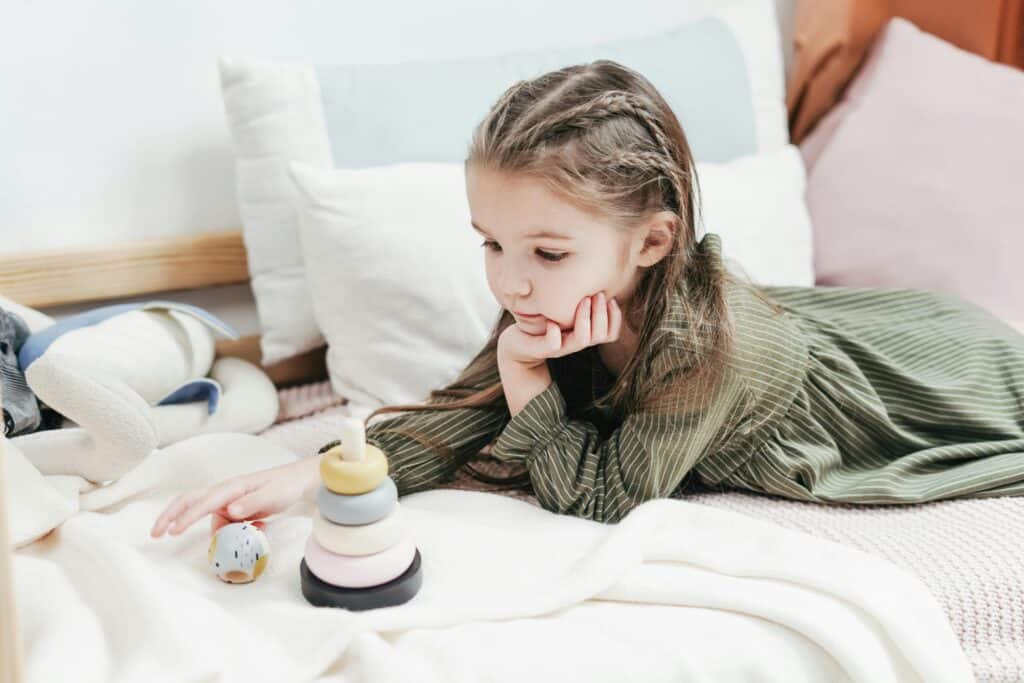It’s never too late to become connected in a healthy way! As in almost every area of parenting kids from hard places, the bad news and the good news are the same: The human brain can always reorganize itself – whether to deal with danger and trauma or to adapt to a new environment of safety and trust. Broken relationships can heal. It just takes determination and hard work.
What can I do to get started?
- Recognize the signs of attachment disorder. Does your child avoid eye contact or refuse to be touched? Is she immature in her language and social skills? Does she comply with your wishes only when she wants something? All these behaviors are typical of a disconnected child. If possible, contact your child’s former foster parents or the foster care system to find out any information about her early life.Six risk factors may be influencing her present behavior:
- Stressful pregnancy
- Difficult birth
- Early hospitalization
- Abuse
- Neglect
- Trauma
- Take a holistic approach. You can make up for the damage done during a child’s early years by starting over at the beginning and “re-doing” the entire developmental process. But remember that this will take time. Even under ideal circumstances, the human brain needs three years of mentoring to develop normal sensory processing. Parents of disconnected kids should expect to invest an equal amount of time to bringing their at-risk children back “online.”
- Understand that healing comes from deep, intuitive insight into the child’s early experiences and a patient, painstaking reversal of negative effects. Give yourself and your child time to grieve the past. Become a good listener. Allow your daughter to tell her own story – don’t tell it for her. Find creative ways to help her express her feelings. For example, you can encourage her to draw pictures representing her personal history or to act it out in puppet play.
- Find a professional therapist. Studies show that without effective treatment, children with attachment disorder and complex trauma become more symptomatic over time. In such cases, family therapy is usually more effective than individual treatment. Choose a therapist who specializes in attachment issues and who makes a point of working with parent and child together.
- Advance the healing process by developing rituals of attachment. Bedtime and mealtime routines fall into this category, as do simple verbal exchanges such as, “Okay?” “Okay.” “See you later, Alligator.” “After a while, Crocodile.” This kind of playful interaction – what Dr. Karyn Purvis calls the “Attachment Dance” – is more an art than a science. It won’t work unless you have fun with it.
- Consider a nutritional approach that includes a dietary plan and/or appropriate supplements. Attachment problems are significantly related to neurochemical imbalances in the brain, so it’s possible that nutritional support may help regulate your child’s mental and emotional state.Be careful with supplements, though. Many high-risk children have suffered a form of brain damage as a result of early trauma. Their nervous systems can’t handle a sudden influx of vitamins and chemicals. Vitamins and drug therapies should, at most, account for only a very small portion of your treatment plan – perhaps 20 percent or less. The rest comes down to behavioral intervention and personal interaction between parent and child.
- Remember that attachment is all about truth, and intimacy is directly connected to the feeling of being understood. In all things, be honest and straightforward with your child, and encourage her to do the same. Create trust by building a home of acceptance and openness. Let your daughter know in every way you can that she is loved with an unconditional love.
Where can I find more help?
If you need help finding a trained Christian counselor who specializes in family attachment therapy, your family pediatrician may be able to recommend a good fit. If not, Focus on the Family’s Counseling department can provide referrals to qualified individuals in your area. Call us for a free phone consultation.
And for more information about parenting adopted children, you might consider a therapeutic parenting model developed by the late Dr. Karyn Purvis called TBRI (Trust Based Relational Intervention). Visit the webpage of TCU’s Karyn Purvis Institute of Child Development for a free one-hour “Introduction to TBRI” online video designed to help parents understand their child’s brain development. You can find other resources through their online store.
Resources
The Connected Child: Bring Hope and Healing to Your Adoptive Family
Adoption & Foster Care (resource list)
Fostering or Adopting Children From Difficult Backgrounds (resource list)
Referrals
TCU’s Karyn Purvis Institute of Child Development
Focus on the Family’s® Foster Care and Adoption Program: Wait No More®
The Adoption Journey (includes lists of books, broadcasts, articles and referrals)











